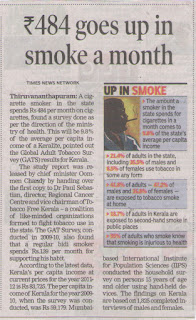 Smokers in the state spend nearly 9 per cent of their income on smoking tobacco products, point out the Kerala findings of the pioneering Global Adult Tobacco Survey (GATS).
Smokers in the state spend nearly 9 per cent of their income on smoking tobacco products, point out the Kerala findings of the pioneering Global Adult Tobacco Survey (GATS).
Shri Oommen Chandy, Hon’ble Chief Minister of Kerala formally released the Kerala report of GATS by handing over the first copy to Dr Paul Sebastian, Director, Regional Cancer Centre and Vice Chairman of Tobacco Free Kerala – a coalition of like-minded organisations formed to fight tobacco use in the state.
The GAT Survey, conducted under the coordination of the Union Ministry of Health and Family Welfare in 2009-10, points out that the monthly expenditure by a smoker on cigarettes is Rs. 484 and on bidis is Rs.139.
According to the latest figures of the Government of India, Kerala’s per capita income at current prices for the year 2011-12 is Rs 83,725. The per capita income of Kerala for the year 2009-10 was Rs. 59,179.
GATS is the global standard for systematically monitoring adult tobacco use and includes information on patterns of tobacco use (smoking and smokeless), cessation, second-hand smoke, economics and perceptions towards tobacco use, among others.
Mumbai-based International Institute for Population Sciences (IIPS) conducted the household survey on persons 15 years of age and older using hand-held devices. The findings on Kerala are based on 1,825 completed interviews of males and females.
The Survey also throws light on the fact that 58.6 per cent of daily tobacco users consume tobacco within half-an-hour of waking up. In Kerala, 21.4 per cent of adults including 35.5 per cent of males and 8.5 per cent of females use tobacco in any form.
It further reveals that there is no escaping the deleterious impact of tobacco even at home. As high as 41.8 per cent of adults - 47.2 per cent of males and 36.8 per cent of females – are exposed to tobacco smoke at home.
In spite of COTPA, 2003 – the comprehensive Indian tobacco control legislation – banning smoking in public places, GATS shows that 18.7 per cent of adults in Kerala are exposed to second-hand smoke in public places. At the workplace, 21.5 per cent of males and 3.7 per cent of females have to put up with toxins smoked by others.
The Global Adult Tobacco Survey - conducted using a consistent and standard protocol across countries - is a critical tool to help our nation fulfil one of its obligations of generating comparable data under the Framework Convention on Tobacco Control (FCTC) of the World Health Organisation (WHO).
The Kerala Fact Sheet can be viewed here
 |
| Malayala Manorama, 14 October 2012 |
 | ||
The Hindu, 12 October 2012
|
 |
| Mathrubhumi, 11 October 2012 |
 |
| Times of India, 11 October 2012 |










